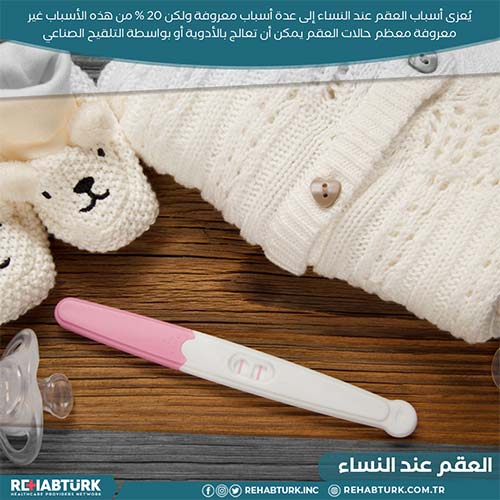Treatment of female infertility in Türkiye
Treatment of infertility in women is done either with endoscopy or with medication, and the method of treatment follows the cause of the main infertility, and in the event that all treatment cases fail, it is possible to move to artificial insemination to carry out pregnancy
What are the causes of infertility in women?
There are a number of things that may prevent you from getting pregnant, and the causes of infertility in women are attributed to several known causes, but 20% of these causes are unknown.
Most cases of infertility can be treated with medication or by artificial insemination
Damage to the fallopian tubes
These structures carry Oocytes from the ovaries, which produce the Oocytes, to the uterus, where the baby develops. The fallopian tubes can be damaged when scar tissue forms after pelvic infections, endometriosis, and pelvic surgery. This can prevent the sperm from reaching the Oocyte in the tube. The Oocyte and sperm meet in the tube. This is where the Oocyte is fertilized and then travels to the uterus for implantation.

hormonal problems
Pregnancy may not occur because your body does not go through the usual hormonal changes that cause an Oocyte to be released from the ovary and thicken the lining of the uterus.
Cervical causes
Some women have a condition that prevents sperm from passing through the cervical canal.
Uterine problems.
You may have polyps and fibroids that interfere with your pregnancy. Uterine polyps occur when too many cells grow in the lining of the uterus. Fibroids grow in the wall of the uterus. Other uterine abnormalities can also overlap,
‘Unexplained’ infertility
For about 20% of couples with infertility problems, the exact causes are never identified.
Female infertility tests
Your doctor may order several tests, including a blood test to check hormone levels and an endometrial biopsy to check the lining of your uterus. of these tests
Hysterosalpingography (HSG).
This procedure involves an ultrasound or X-ray of the reproductive organs. The doctor injects dye or saline and air into the cervix, which travels up through the fallopian tubes.
Using this method, your doctor can check to see if the tubes are blocked.
laparoscopy
Your doctor places a laparoscope — a thin tube with a small camera — through a small cut near your belly button. This allows him to see the outside of the uterus, ovaries and fallopian tubes to check for abnormal growths. The doctor can also see if the fallopian tubes are blocked.
How is female infertility treated?
Hysteroscopy for the treatment of female infertility
If you are diagnosed with cervical or pelvic disease, one option is to have surgery to reconstruct the reproductive organs.
The doctor places a laparoscope through a cut near your abdomen to get rid of scar tissue, treat endometriosis, open blocked tubes, or remove ovarian cysts , which are fluid-filled sacs that can form in your ovaries.
Hysteroscopy treatment of female infertility
In this procedure, your doctor places a hysteroscope into the uterus through the cervix. It is used to remove polyps and fibroids , section off scar tissue, and open blocked tubes.
Medicines to treat female infertility
These medications can also help you get pregnant by causing your ovaries to release too many Oocytes. Normally, only one Oocyte is released each month.
Your doctor may suggest that you take gonadotropin if you have unexplained infertility or when other treatments haven’t helped you get pregnant.
Treating female infertility with intrauterine insemination
In this procedure, after mixing the semen with a special solution, the doctor places it in the uterus during ovulation. This is sometimes done while you are taking medication that helps the Oocyte to be released.
IVF.
In this technique, your doctor places the fertilized embryos into your uterus in a laboratory dish.
The gonads are stimulated to develop more than one Oocyte. When the Oocytes are ready, the doctor collects them using ultrasound and inserts them with a needle.
The sperms are then collected and added to the Oocytes in a laboratory dish. After several days, the embryos – or fertilized Oocytes – are returned to the uterus using a device called an intrauterine insemination catheter.
It is best to have additional embryos frozen and preserved for later use.
ICSI
(Intracytoplasmic sperm injection). The doctor injects the sperm directly into the Oocyte in a laboratory dish and then places it in the uterus.
GIFT (gamete transfer into the fallopian tubes)
Transfer of gametes to the fallopian tube (GIFT from English Gametes Intra Fallopian Transfer). The Oocytes are taken from the follicles, by laparoscopy , by suctioning them into small catheters. Once taken, the Oocyte cells are selected according to the degree of maturity and transferred into a cannula containing a certain amount of semen.
Inside the Oocyte and sperm remain separated by air bubbles that prevent contact. The contents of the tube are then released, allowing the Oocyte and sperm to meet at the natural fertilization site. In fact, the fallopian tubes are not simple channels of communication between the ovaries and the uterus, but they are channels capable of stimulating the movement of embryos and providing them with all the nutrients they need.
Also in this case, the number of Oocytes listed depends on the age of the woman; Generally three if younger than 36 and four when over that age. If possible, the contents of the small catheter are distributed in the two tubes, otherwise in only one available for fertilization.
Therefore, human intervention is very limited compared to other techniques, and fertilization is largely carried out according to the laws established by nature. for this reason .
In order for this method to be correct, a certain quality of sperm is necessary, which, although less numerous and motile than normal, still has a higher chance of fertilizing the Oocyte.
ZIFT (zygote transfer).
Zygote transfer is a possible solution for conceiving children in many types of infertility, as long as the uterine tubes are healthy and suitable for carrying the fertilized Oocyte in the uterus.
Your doctor may recommend this method if your partner has a small amount of sperm or if you have problems with ovulation. The only cases in which a zygotic intrafalopian cannot be used are when:
- The uterine tubes are blocked or obstructed.
- The uterine tubes are almost completely damaged;
- There are anatomical problems or disorders in the uterus.
- The sperm is unable to penetrate the Oocyte.
The procedure is not one of the most used or common techniques in human reproduction. It is used when methods such as in vitro fertilization, intrauterine insemination, or ovarian stimulation have failed.
Oocyte donation.
This can help if you have ovaries that are not working properly but you have a normal uterus. It involves removing Oocytes from the ovaries of a donor who has taken fertility drugs. After in vitro fertilization, your doctor transfers the fertilized Oocytes into your uterus.
How can I book for female infertility treatment in Türkiye?

- Free medical support on the phone: You will have a dedicated representative for your health condition who is always ready to answer your questions.
- Free consultation with a specialist doctor: Your medical representative will consult with a number of doctors and hospitals to find the best possible treatments.
- Free travel visa arrangement: We will contact the embassy in your country to assist you in obtaining a visa to visit Türkiye.
- Free itinerary planning: We will create a schedule for your medical trip to Türkiye.
- Free translation of documents and reports: We will translate medical documents and reports into Turkish on your behalf.
- Free support and monitoring: We will monitor the stages of treatment and be by your side every step of the way.
- Free instant translation: We will be with you during the treatment stages to provide translation between you and the medical team.
- Free accommodation and transportation coordination: We will book accommodation for you and your companions in Türkiye, along with transportation services.
Contact REHABTÜRK doctors for more information about the procedure and to evaluate your medical condition.
